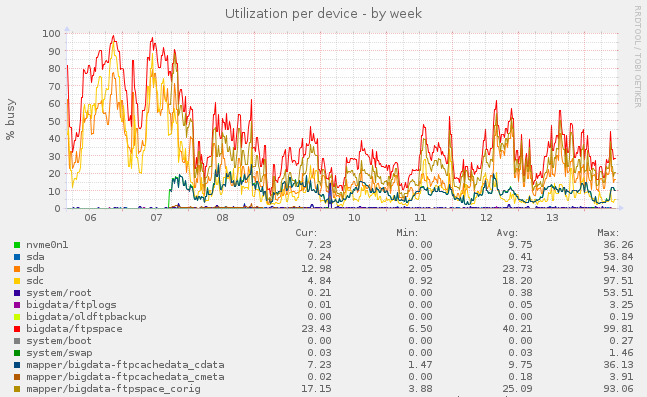The total outgoing traffic of ftp.fau.de increased from 5.04 PiB in 2021 to 6.57 PiB in 2022, an increase of 30%.
| Rank | Mirror | Traffic 2022 in TB | Rank/Traffic 2021 (for comparison) |
|---|---|---|---|
| 1 | mint/iso (Linux distribution, disc images) | 1075 | 1 / 849 |
| 2 | centos (Linux distribution) | 780 | 10 / 160 |
| 3 | kiwix (offline Wikipedia) | 726 | 2 / 519 |
| 4 | fdroid (Free and Open-Source Android app repository) | 494 | 3 / 304 |
| 5 | qtproject (Qt Toolkit) | 295 | 4 / 275 |
| 6 | fedora (Linux distribution) | 293 | 8 / 186 |
| 7 | opensuse (Linux distribution) | 270 | 9 / 175 |
| 8 | eclipse | 238 | 7 / 193 |
| 9 | lineageos (Free and Open-Source Android distribution) | 189 | 6 / 199 |
| 10 | gimp (Free and Open-Source image manipulation program) | 173 | 5 / 266 |
The percentage of IPv6 traffic dropped slightly, it is now at 26% (1.68 PiB), after 27% in 2021, 27% in 2020, 25% in 2019, 22% in 2018, 22% in 2017, 14% in 2016 and 11% in 2015.
There is very little change in the Top 10 overall. Sure, some mirrors got a little more or a little less traffic, and thus changed position in the Top 10, but fluctuations are little and nothing really stands out. There is not a single new entry into the Top 10.
The notable exception seems to be CentOS, which jumped from rank 10 to 2. We’re a bit surprised by that, considering what has happened to this project in the last 2 years (you’ll need to read up on that elsewhere). The likely explanation is probably, that after RedHat turned this into an abomination of the original project, most other mirrors stopped mirroring – and as one of the few remaining mirrors we now see a lot more traffic to the mirror. That won’t last forever though: Newer versions of “CentOS stream” (starting with 9) are distributed through a different mirror network now, and we neither are nor plan to be a part of that. We will only keep the existing mirror running as long as there are still CentOS 7 updates to distribute (supposedly on 2024-06-30, but after spontanously pulling the plug on CentOS 8 with just a few months notice, would you really trust that company to keep their promises for CentOS 7?).
We will end this post by explaining why “gimp” is almost the only mirror whose total traffic (in TB) dropped from 2021 to 2022: In September 2022, we noticed that we were accidently listed twice in gimps automatic mirror redirector, meaning we served twice as many downloads as the other mirrors. Since that error has (sadly) been corrected now, we’re getting a lot less traffic from gimp.
